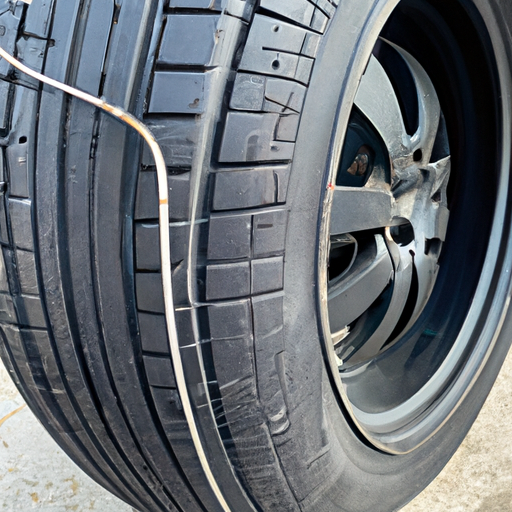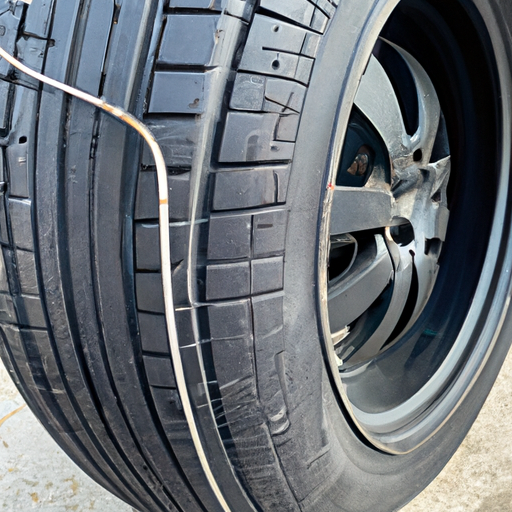If you’ve ever wondered about the correct method for inflating your tires, look no further. This article will guide you through the proper way to inflate your tires, ensuring a smooth and safe driving experience. By following these simple steps, you can maintain the optimal tire pressure and maximize the lifespan of your tires. Say goodbye to uneven wear and poor fuel efficiency – it’s time to get your tire inflation game on point. Let’s dive in and discover the proper way to inflate your tires.
Check your tires’ recommended PSI
Find the recommended PSI
Before inflating your tires, it’s important to know the recommended PSI (pounds per square inch) for your specific tires. This information can usually be found in your vehicle’s owner’s manual, on a sticker inside the driver’s side door jamb, or sometimes on the sidewall of the tire itself. Take a moment to locate this information as it will be crucial for ensuring you inflate your tires to the correct pressure.
Use a tire pressure gauge
To accurately measure your tire pressure, you’ll need a tire pressure gauge. These handy tools are relatively inexpensive and can be found at most auto parts stores or even online. Make sure you choose a gauge that is compatible with your tire’s valve system (either Schrader or Presta). Using a tire pressure gauge will allow you to get an accurate reading of your tire pressure, which is important for maintaining optimal performance, fuel efficiency, and safety.
Refer to the vehicle manual
If you’re unsure about any aspect of your tire inflation process, it’s always a good idea to refer to your vehicle’s owner’s manual. It will provide you with valuable information specific to your make and model, including the recommended PSI, proper tire care, and maintenance guidelines. By consulting your manual, you can ensure that you’re following the manufacturer’s instructions and are fully informed about the best practices for inflating your tires.
Determine current tire pressure
Check the sidewall
While the sidewall of your tire may provide you with information about the maximum pressure the tire can handle, it’s not the most accurate way to determine the current tire pressure. The recommended PSI may differ from the maximum PSI, so it’s important to use a tire pressure gauge for an accurate reading. Relying solely on visual inspection of the sidewall won’t give you an accurate measurement, as tires can lose pressure over time due to various factors such as temperature changes or small leaks.
Use a tire pressure gauge
As mentioned earlier, using a tire pressure gauge is the most reliable way to determine the current pressure in your tires. Simply remove the valve stem cap, attach the gauge to the valve stem, and press firmly until the hissing sound stops. The gauge will display the current pressure in PSI, allowing you to compare it to the recommended PSI for your tires. If the pressure is lower than recommended, it’s time to inflate your tires.
Do not rely on visual inspection alone
While visual inspection can give you a rough estimate of whether your tires appear underinflated, it’s not a reliable method for determining the actual tire pressure. Tires can lose pressure gradually, and it’s not always visually apparent. Avoid relying on visual inspection alone and always use a tire pressure gauge for an accurate measurement. This will ensure that your tires are properly inflated and that you’re driving safely and efficiently.

Choose the right tire inflator
Types of tire inflators
When it comes to inflating your tires, you have a few different options for tire inflators. The most common types include handheld tire inflators, portable air compressors, and air pumps. Handheld tire inflators are compact and portable, making them great for on-the-go inflation. Portable air compressors are more powerful and can inflate tires quickly, but they are bulkier and require a power source. Air pumps, on the other hand, are manual and do not require electricity, but they may take longer to inflate your tires.
Consider your needs
When choosing a tire inflator, it’s important to consider your specific needs and preferences. If you often find yourself needing to inflate your tires while on the road, a handheld tire inflator may be the most convenient option. If you have access to electricity and need to inflate your tires quickly, a portable air compressor may be your best bet. However, if you prefer a manual and more budget-friendly option, an air pump could be the right choice. It all depends on your individual requirements and circumstances.
Quality and features
Regardless of the type of tire inflator you choose, it’s important to prioritize quality and features. Look for a tire inflator that is well-made, durable, and reliable. Check customer reviews and ratings to ensure that you’re purchasing a reputable brand. Additionally, consider features such as an automatic shut-off function, LED lights for visibility in low-light conditions, and a built-in pressure gauge for added convenience. Investing in a high-quality tire inflator will help make the tire inflation process easier and more efficient.
Prepare the necessary tools
Tire pressure gauge
To properly inflate your tires, a tire pressure gauge is essential. As mentioned earlier, make sure to choose a gauge that is compatible with your tire’s valve system (Schrader or Presta). Having a tire pressure gauge on hand will allow you to accurately measure the pressure before and after inflation, ensuring that your tires are inflated to the recommended PSI.
Air compressor or pump
Depending on the type of tire inflator you choose, you may need an air compressor or pump. If you opt for a handheld tire inflator or portable air compressor, ensure that you have access to a power source, such as your vehicle’s cigarette lighter or a wall outlet. If you choose an air pump, make sure it is in good working condition and capable of inflating your tires to the recommended PSI.
Valve stem caps
Valve stem caps may seem like a small detail, but they play an important role in maintaining tire pressure. They help to keep out dirt, debris, and moisture, preventing leaks and maintaining the integrity of the valve stem. Before inflating your tires, remove the valve stem caps and set them aside in a safe place. You’ll need to screw them back on once the inflation process is complete.
Inflation adapters
In some cases, you may require inflation adapters to ensure a proper fit between your tire inflator and the valve stem. These adapters come in different sizes and can be extremely useful if your valve stem does not match the connector on your tire inflator. Make sure to have the necessary inflation adapters on hand to avoid any issues during the inflation process.

Inflate tires when cold
Why cold tires matter
It’s crucial to inflate your tires when they are cold. Cold tires refer to tires that haven’t been driven on or exposed to direct sunlight for at least three hours. Inflating warm or hot tires can result in inaccurate readings and potentially overinflating your tires. As tires heat up during driving, the pressure inside them increases, so measuring and adjusting tire pressure when cold will give you the most accurate results.
Avoid inflating after driving
As mentioned earlier, tires heat up during driving. Inflating your tires immediately after driving can give you an inaccurate reading and lead to overinflation. The increased pressure from driving can make your tires appear to have sufficient pressure when, in reality, they may be overinflated once they cool down. To avoid this, always wait until your tires have had time to cool down before inflating them.
Allow tires to cool down
To ensure accurate tire pressure readings, it’s essential to allow your tires to cool down before inflating them. Park your vehicle in a shaded area or in the garage and let your tires sit for at least three hours. This will allow the tires to cool to the ambient temperature, giving you a more accurate reading on your tire pressure gauge. By waiting for your tires to cool, you’ll be able to avoid any potential issues that could arise from inflating warm or hot tires.
Remove the valve stem caps
Locate the valve stems
Each tire has a valve stem, which is the small metal or rubber cylinder protruding from the wheel. The valve stem is where you’ll attach the tire inflator. Take a moment to locate the valve stems on your tires. They are usually found on the outer side of the wheel, near the tire sidewall. Once you’ve located the valve stems, you’re ready to begin the inflation process.
Unscrew the valve stem caps
Before attaching the tire inflator, you’ll need to remove the valve stem caps. These caps help to keep out dirt and moisture, ensuring a proper seal. Unscrew the valve stem caps by turning them counterclockwise. Be sure to set the caps aside in a safe place so that you don’t misplace them during the inflation process. Removing the valve stem caps will allow you to attach the tire inflator securely.
Set them aside for later
As mentioned earlier, it’s important to keep track of the valve stem caps during the inflation process. Once you’ve removed them, set them aside in a safe and easily accessible place. After you have finished inflating your tires and have reattached the caps to the valve stems, you can store them back in place. Taking care of the valve stem caps will help to maintain the integrity of your tire’s valve system and prevent any potential leaks.

Connect the air compressor or pump
Determine the type of valve
Before connecting the tire inflator, it’s important to determine the type of valve system your tires have. Most cars have Schrader valves, while some bikes may have Presta valves. Schrader valves are larger and have a spring-loaded valve core, while Presta valves are narrower and have a built-in valve core that is unscrewed for inflation. Understanding the type of valve system your tires have will ensure a proper connection with the tire inflator.
Connect the inflator hose
Once you’ve determined the type of valve system, it’s time to connect the inflator hose to the valve stem. For Schrader valves, simply press the inflator hose onto the valve stem until it fits securely. You may need to hold the hose firmly in place to create a tight seal. For Presta valves, unscrew the valve cap, press down on the valve to release any air inside, and then press the inflator hose onto the valve stem until it fits securely.
Ensure a secure connection
After attaching the inflator hose to the valve stem, it’s crucial to ensure a secure connection before inflating your tires. A loose connection may result in air leakage and inaccurate readings. Check that the inflator hose is firmly attached to the valve stem, without any gaps or spaces between them. Once you’re confident in the secure connection, you’re ready to move on to the inflation process.
Inflate the tires gradually
Start with a low pressure
When inflating your tires, it’s important to start with a lower pressure than the recommended PSI. This allows you to add air gradually and avoid overinflating your tires. Begin by inflating your tires to a pressure slightly below the recommended PSI. This will give you room to make small adjustments as needed and ensure that you’re not overinflating the tires from the start.
Check and adjust as necessary
After initially inflating your tires to a slightly lower pressure, it’s time to check the pressure using your tire pressure gauge. Remove the gauge from the valve stem and read the pressure displayed. Compare this reading to the recommended PSI for your tires. If the pressure is too low, continue adding air in small increments until you reach the recommended PSI. If the pressure is too high, you can release some air by pressing down on the valve core with a small object.
Avoid overinflating
Overinflating your tires can lead to uneven wear, reduced traction, and decreased handling performance. It’s crucial to avoid overinflating your tires by carefully monitoring the pressure and making small adjustments as needed. Take your time during the inflation process and be patient. By following the recommended PSI and inflating your tires gradually, you’ll ensure that they are properly inflated and ready for safe and efficient driving.

Check the tire pressure
Use a tire pressure gauge
After inflating your tires, it’s important to double-check the pressure using a tire pressure gauge. This step ensures that you have accurately inflated your tires to the recommended PSI. Remove the gauge from the valve stem and read the displayed pressure. Compare this reading to the recommended PSI for your tires. If the pressure matches the recommended PSI, you can move on to the next tire. If the pressure is off, make any necessary adjustments before proceeding.
Measure all tires
Remember to measure the pressure in all four tires, as each tire may have a different pressure requirement. It’s essential to maintain consistent pressure among all tires to ensure even wear and optimal performance. After measuring the pressure in one tire, move on to the next tire until you have checked and adjusted the pressure in all of your tires. Taking the time to measure all tires will help ensure that your vehicle is safe and ready for the road.
Adjust as needed
If you find that the pressure in any of your tires is off, make the necessary adjustments using your tire inflator and pressure gauge. Add air if the pressure is too low, or release air if the pressure is too high. Remember to make small adjustments and always double-check the pressure after each adjustment. By maintaining the correct tire pressure, you’ll ensure that your tires wear evenly, maximize fuel efficiency, and provide you with a safe and comfortable driving experience.
Regularly monitor tire pressure
Check at least once a month
Inflating your tires to the correct pressure is just the first step in proper tire maintenance. To ensure that your tires maintain the correct pressure over time, it’s important to regularly monitor them. Make it a habit to check your tire pressure at least once a month, or even more frequently if you drive long distances or experience extreme temperature changes. Regular checks will help you catch any gradual pressure loss and address it before it becomes a significant issue.
Monitor during temperature changes
Temperature changes can have a significant impact on tire pressure. As the outside temperature fluctuates, your tire pressure can increase or decrease accordingly. It’s essential to monitor your tire pressure during extreme temperature changes, such as during seasons with drastic temperature shifts or before long road trips. Keeping an eye on your tire pressure during these times will ensure that your tires stay properly inflated and help prevent unnecessary wear or safety issues.
Consult a professional if unsure
If you’re unsure about any aspect of tire inflation or maintenance, don’t hesitate to consult a professional. Tire experts, such as mechanics or tire technicians, have the knowledge and experience to guide you through the proper tire inflation process. They can answer any questions you may have and provide valuable advice to ensure that your tires are inflated correctly for optimal performance and safety. When in doubt, it’s always better to seek professional assistance to ensure that you’re taking the best care of your tires.


